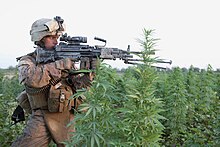Cannabis and the United States military
| Part of a series on |
| Cannabis |
|---|
 |

Cannabis usage is currently prohibited in the United States military, but historically it has been used recreationally by some troops, and some cannabis-based medicines were used in the military as late as the twentieth century.
Military medicine
In 1909, a military manual from the Mounted Service School in Fort Riley recommended cannabis indica for treating abdominal pains in horses, or to supplement ether for treating spasms.[1] During World War I, military doctors recommended that the American Expeditionary Force carry cannabis indica tablets to treat headaches, insomnia, and cramps.[2]
Drug use in Panama and investigations
Some of the earliest reports of recreational cannabis use in the military came from the Panama Canal Zone in 1916, where troops were noted to be using the drug.[3][4] Also in 1916, thousands of US troops used marijuana while in Mexico on General John Pershing's punitive expedition against Pancho Villa (1916–1917).[5] In 1921, the commanding officer of Fort Sam Houston in San Antonio, Texas, prohibited the use of cannabis on the base.[6]
A 1933 report by the U.S. Army Medical Corps published in the publication Military Surgeon, titled Marijuana Smoking in Panama, based on a study of U.S. Army personnel in the Panama Canal Zone, found that cannabis was generally not addictive and was less harmful to soldiers than alcohol.[7][8] The report recommended that use of cannabis on military bases should continue to be prohibited, but outside of these areas there should be no further restriction.[8]
Industrial hemp
The Rens Hemp Company of Brandon, Wisconsin, closed in 1958, was the last legal hemp producer nationwide in operation following World War II.[9] Prior to its 1957 shutdown, Rens had been the primary provider of hemp rope for the United States Navy.[10]
Edgewood Arsenal human experiments
From the 1950s to the 1970s, Edgewood Arsenal conducted experiments on human subjects with cannabis and its derivatives.[11][12] One study indicated "no loss of motivation or performance after two years of heavy (military sponsored) smoking of marihuana."[13]
Vietnam War
Though alcohol was the drug most commonly used by American troops in the Vietnam War, cannabis was the second-most common. Initially rates of usage among deployed soldiers were comparable to those of their stateside peers, with 29% of troops departing Vietnam in 1967 reporting having ever used marijuana in their lives. A 1976 study however showed that from 1967 to 1971, the proportion of troops having used marijuana peaked at 34% before stabilizing to 18%, while the number of troops who had used cannabis prior to deployment stayed around 8%.[14] Cannabis use by troops in Vietnam was generally dealt with using Article 15 non-judicial punishment in units such as the 101st Airborne.[15]
During the Vietnam War period, cannabis use also became common among US forces in the United States and in Europe, with a 1971 article claiming that over 1,000 midshipmen at Annapolis Naval Academy used cannabis, and a survey in Germany showing that half of the soldiers in the surveyed battalion were regular cannabis users.[16]
References
- ^ United States. Mounted Service School, Fort Riley, Kan (1909). The army horse in accident and disease: edition: 1909. A manual prepared for the use of students of the Training school for farriers and horseshoers. Govt. print. off. pp. 110–.
{{cite book}}: CS1 maint: multiple names: authors list (link) - ^ Brendan I. Koerner (May 29, 2008). Now the Hell Will Start: One Soldier's Flight from the Greatest Manhunt of World WarII. Penguin Publishing Group. pp. 87–. ISBN 978-1-4406-3387-4.
- ^ The International Journal of the Addictions. M. Dekker. 1982.
- ^ Richard E. Hardy; John G. Cull (June 1973). Drug dependence and rehabilitation approaches. Thomas. p. 91. ISBN 978-0-398-02690-5.
- ^ Curtis Marez (2004). Drug Wars: The Political Economy of Narcotics. U of Minnesota Press. pp. 111–. ISBN 978-0-8166-4060-7.
- ^ Charles H. Whitebread (1974). The Marijuana Conviction: A History of Marijuana Prohibition in the United States. Lindesmith Center. p. 35. ISBN 978-1-891385-06-3.
- ^ Ruth C. Stern & J. Herbie DiFonzo, The End of the Red Queen's Race: Medical Marijuana in the New Century, Quinnipiac Law Review, Vol. 27, p. 688.
- ^ a b Marijuana Smoking in Panama, Military Surgeon, Vol. 73 (1933).
- ^ TAPPI Journal. Technical Association of the Pulp and Paper Industry. 1999. p. 114.
- ^ John Roulac (January 1, 1997). Hemp Horizons: The Comeback of the World's Most Promising Plant. Chelsea Green Pub. p. 59. ISBN 978-0-930031-93-0.
- ^ United States. Congress. Senate. Committee on the Judiciary. Subcommittee to Investigate Juvenile Delinquency (1975). Marijuana Decriminalization: Hearing Before the Subcommittee to Investigate Juvenile Delinquency of the Committee on the Judiciary, United States Senate, Ninety-fourth Congress, First Session ... May 14, 1975. U.S. Government Printing Office. pp. 942–.
- ^ Understanding the Social Costs of Marijuana Laws: With Emphasis on the Medical Aspects. The Committee. 1974.
- ^ Joseph W. Jacob; Joseph W. Jacob B. a. M. P. a. (October 2009). Medical Uses of Marijuana. Trafford Publishing. pp. 102–. ISBN 978-1-4269-1540-6.
- ^ Roy W. Menninger; John C. Nemiah (November 1, 2008). American Psychiatry After World War II (1944-1994). American Psychiatric Pub. pp. 23–. ISBN 978-1-58562-825-4.
- ^ Judge Advocates in Vietnam: Army Lawyers in Southeast Asia, 1959-1975. DIANE Publishing. 2003. pp. 66–. ISBN 978-1-4289-1064-5.
- ^ James Westheider (2011). Fighting in Vietnam: The Experiences of the U.S. Soldier. Stackpole Books. pp. 173–. ISBN 978-0-8117-0831-9.